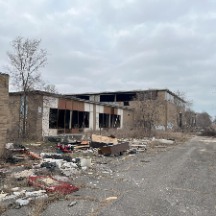Alfred Beckman Middle School is within walking distance of other abandoned schools in Gary, Indiana, including Theodore Roosevelt High School and David O. Duncan and Henry Highland Garnet Elementary Schools. Two Port of Harlem followers recently offered opposing views on the situation and a remedy at a Gary Common Council meeting.
Unlike in Washington, DC, abandoned schools have not been given a second life as expensive condominiums. DC's former Edmonds School has a one-bedroom, one-bath, 500-square-foot apartment that costs $1,900 monthly and sells for $500,000.
With much controversy, the Gary Common Council recently voted 5-4 to rezone the abandoned Beckman School to light industrial, paving the way for a new tax-paying, 261,000-square-foot "flex" building capable of housing up to six industrial tenants.
The two Port of Harlem magazine followers had interesting opposing positions on the rezoning. "We are poised to construct a massive light industrial, warehouse, office (flex) building with dozens of truck docks, several stories high in the midst of the midtown residential area of the struggling Black Community," said Kwabena Sakidi Jijaga Rasuli.
Additionally, under a new bill recently signed by the Republican Indiana governor, Gary Community School Corporation is expected to lose $12.5 million in revenue over the next three years.
However, John Allen approved the new investment. "Too many locals do not believe they pay more in rent, taxes, and services because so much of our land is ''not used,'' and the population is low and mostly fixed income," added Allen.
The Gary Community School Corporation closed Beckman in 2005. At its peak, the school system had seven high schools. Today, only one remains, and most of the closed buildings are still standing due to a lack of funds to tear them down or investor interest in renovating them.
Like many other challenged communities, Gary has low voter turnout and census participation rates, which affects its potency. During the 2020 Census, White Republican strongholds such as Dyer, IN, had a self-mail-back rate of 65 percent by the end of March 2020. By contrast, only 34 percent of Gary residents had returned their forms.
Urban Dilemma: Unloved Investor vs. Badly Needed Income
Money


In the 2022 election, only 43 percent of Garyites voted, leaving the Democratic Congressperson with a fragile 53 percent of the vote to defeat the Republican challenger. Only 43 percent of registered voters showed up at the polls in Gary versus the 67 percent who showed up in White, Republican Dyer.
Additionally, under a new bill recently signed by the Republican Indiana governor, Gary Community School Corporation is expected to lose $12.5 million in revenue over the next three years. The bill aims to reduce property taxes, directly benefiting those who own property and the most expensive properties.
However, Gary continues to see housing renovation throughout the city, including a brick ranch house across the street from the abandoned David O. Duncan Elementary School.
Allen added that he recently sold a fully renovated home directly across the street from an "actual truck stop" "in less than 30 days." The three-bedroom, one-bath, 1,700-square-foot detached house sold for $135,000.
Allen referred to Djuric Trucking, which recently moved its tax-paying corporate headquarters from neighboring Hammond into Gary after demolishing the old Edison High School. It faced similar rezoning controversies.
Note: After the 5-4 vote to rezone the abandoned Beckman School, Mayor Eddie Melton provided a pocket view. The change in Councilperson Marian Ivey's vote provided the sixth vote needed by Indiana law to override the mayor's veto. She told the Northwest Indiana Times that conversations with Councilperson Barnes-Caldwell, whose district contains the Beckman property, and with the developers' attorney helped change her mind. "I do believe that ultimately the citizens will be relieved that that eyesore will be gone away," Ivey said.
Additionally, under a new bill recently signed by the Republican Indiana governor, Gary Community School Corporation is expected to lose $12.5 million in revenue over the next three years. The bill aims to reduce property taxes, directly benefiting those who own property and the most expensive properties.
However, Gary continues to see housing renovation throughout the city, including a brick ranch house across the street from the abandoned David O. Duncan Elementary School.
Allen added that he recently sold a fully renovated home directly across the street from an "actual truck stop" "in less than 30 days." The three-bedroom, one-bath, 1,700-square-foot detached house sold for $135,000.
Allen referred to Djuric Trucking, which recently moved its tax-paying corporate headquarters from neighboring Hammond into Gary after demolishing the old Edison High School. It faced similar rezoning controversies.
Note: After the 5-4 vote to rezone the abandoned Beckman School, Mayor Eddie Melton provided a pocket view. The change in Councilperson Marian Ivey's vote provided the sixth vote needed by Indiana law to override the mayor's veto. She told the Northwest Indiana Times that conversations with Councilperson Barnes-Caldwell, whose district contains the Beckman property, and with the developers' attorney helped change her mind. "I do believe that ultimately the citizens will be relieved that that eyesore will be gone away," Ivey said.
Advertisers | Contact Us | Events | Links | Media Kit | Our Company | Payments Pier
Press Room | Print Cover Stories Archives | Electronic Issues and Talk Radio Archives | Writer's Guidelines






